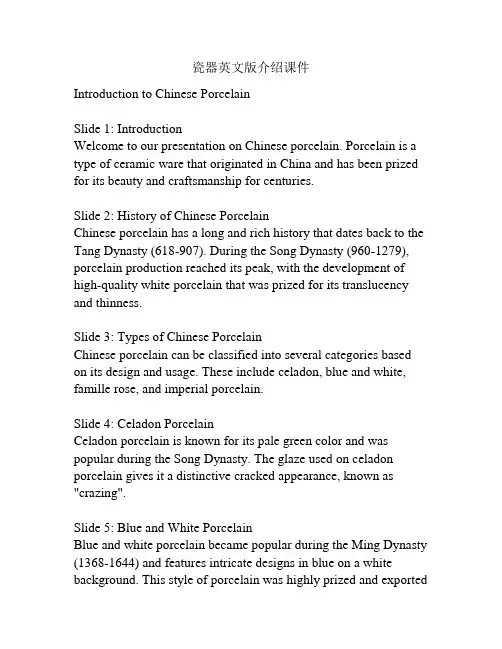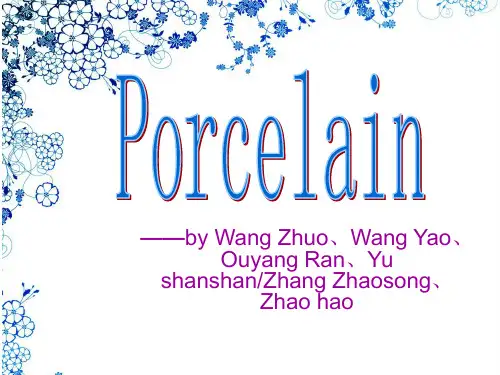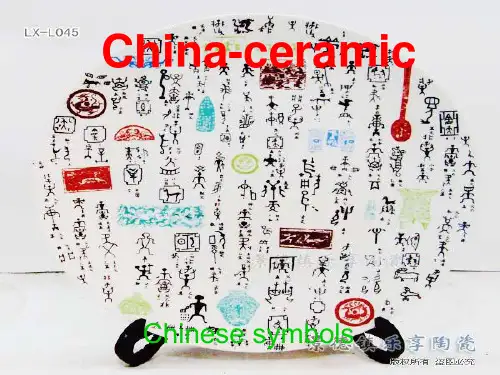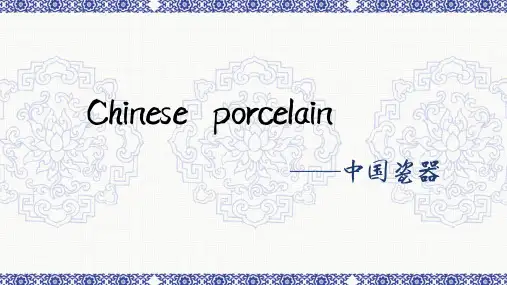中国瓷器—英语.ppt
- 格式:ppt
- 大小:3.89 MB
- 文档页数:17








瓷器英文版介绍课件Introduction to Chinese PorcelainSlide 1: IntroductionWelcome to our presentation on Chinese porcelain. Porcelain is a type of ceramic ware that originated in China and has been prized for its beauty and craftsmanship for centuries.Slide 2: History of Chinese PorcelainChinese porcelain has a long and rich history that dates back to the Tang Dynasty (618-907). During the Song Dynasty (960-1279), porcelain production reached its peak, with the development of high-quality white porcelain that was prized for its translucency and thinness.Slide 3: Types of Chinese PorcelainChinese porcelain can be classified into several categories based on its design and usage. These include celadon, blue and white, famille rose, and imperial porcelain.Slide 4: Celadon PorcelainCeladon porcelain is known for its pale green color and was popular during the Song Dynasty. The glaze used on celadon porcelain gives it a distinctive cracked appearance, known as "crazing".Slide 5: Blue and White PorcelainBlue and white porcelain became popular during the Ming Dynasty (1368-1644) and features intricate designs in blue on a white background. This style of porcelain was highly prized and exportedto many countries around the world.Slide 6: Famille Rose PorcelainFamille rose porcelain is known for its bright colors and intricate designs. It was developed during the Qing Dynasty (1644-1911) and was used primarily for decorative purposes.Slide 7: Imperial PorcelainImperial porcelain was reserved for use by the royal family and had special markings such as dragons or the imperial seal. These pieces were made with the highest quality materials and craftsmanship.Slide 8: Famous Chinese PorcelainThere are many famous pieces of Chinese porcelain that are still highly prized today. These include the Ming Dynasty Xuande blue-and-white dragon jar and the Qing Dynasty Qianlong famille-rose vase.Slide 9: ConclusionChinese porcelain is a unique and beautiful art form that has been highly prized for centuries. Its beauty and craftsmanship continue to inspire and amaze people around the world today. Thank you for joining us for this introduction to Chinese porcelain.。

——by Wang Zhuo、Wang Yao、Ouyang Ran、Yu shanshan/Zhang Zhaosong、Zhao haoLet’s Begin Our Trip at Jingde ZhenJingdezhensightseeingJingdezhen. is very famous as “the capital of porcelain" It's China's main porcelain-making center since the Song dynasty, as early as 1712 needed to keep three thousand kilns fired day and night.Three main kinds of porcelain•hard-paste porcelain(硬瓷)•soft-paste porcelain(釉瓷)•bone china(骨瓷)The blue and white porcelain•Blue and whiteporcelain enameltransparent water, tires,white light thin body ofporcelain body apply toblue, elegant decoration,pure and fresh vitality.Once appear blue rage,become the writings ofjingdezhen tradition.Tri-coloured glazed pottery of theTang DynastyThe Histroy of PorcelainNeolithic age(石器时代)In the history of Chinese ceramics, porcelain derived frompottery(陶)and appeared later. In the early years,people have made splendid achievements in ceramic fieldespecially in Yellow River and Changjiang River drainagearea where a lot of potteries and pottery fragments in theNeolithic age were unearthed at historical sites. Some ofthem were not only commodities, but also artworks suchas ancient painted pottery and pottery figurine(塑像).With the development of pottery industry, the previousclay-strip forming technique has been changed to throwclay(粘土)method,while advanced side-fired kiln andshaft kiln replaced ground firing. People at that time alsogot some experience on how to control the temperature.The highest firing temperature had reached 1100℃, whichwas quite close to the firing temperature between potteryand porcelain. In the early period of Yin and ShangDynasty,the appearance of white pottery whose materialDong Han、W ei、Jin In Dong Han Dynasty, the appearance of mature celadon(青瓷)in Yue kiln was a milestone in the history of Chinese ceramics. Wei Dynasty, Jin Dynasty, the South and North Dynasty were just the seedtime. At that time, celadon played an important role in ceramics, which was widely fired. In the mean time, a small quality of black glazed(上釉的)porcelain and white glazed porcelain were discovered. Because of the unity of different nations and the introduction of Buddhism(佛教), the ceramic style became various duringSui and Tang Dyansty In Sui and Tang Dyansty, the Chinese politics, economy, culture and trade became unprecedentedly prosperous, which promoted the progress of ceramics industry, the expansion of ceramic market and later formed the situation of "celadon in south and white porcelain in north."(南青北白) Celadon was the main product of South China. Yue kiln was the typical representative with high artistic value. The tyre(胎)was light, thin and compact; the glaze layer(釉面)was transparent and exquisite. White porcelain of Xing kiln in Tang Dynasty was the representative of "North white". The degree of whiteness in both body and glaze was good. Its body was compact and usually had a ringing sound when being knocked.tri-coloured glazedpottery of the TangDynastySong Dynasty Song Dynasty was the third prosperous period of the feudal society. Technology, culture, art and handicraft were highly developed. The ceramic industry was flourishing too. Porcelain kilns with regional feature spread all over the country, which formed the layout of "six kiln factions(派系)" and "five famous kilns". "Six kiln factions" were Ding kiln faction, Jun kiln faction, Yaozhou kiln faction, Cizhou kiln faction, Longquan kiln faction and Jingdezhen kiln faction. "Five famous kilns" were Guan kiln, Ru kiln, Ge kiln, Ding kiln and Jun kiln. After the establishment of Guan kilns in Song Dynasty, different artistic styles were formed in folk kilns.The famous porcelain city Jingdezhen grew up in Yuan Dynasty, and it was known for its blue-and-white porcelain, underglazed red porcelain and egg white porcelain.Ding kiln Guan kilnMing and Qing Dynasty In Ming and Qing Dynasty, Chinese porcelain art took on a brilliant and splendid look after thousands of years of development. Ancient painted porcelain became prosperous: such as blue-and-white, wu-cai, dou-cai, plain tri-color, underglazed san-cai, enamel color, fen-cai and so on. The painted porcelains in Ming and Qing Dynasty merged the ceramic art into a whole and gradually became perfect. Single color glaze were of various kinds: sacrificial red glaze, sacrificial blue glaze, Lang kiln red glaze, Jiangdou red glaze, yellow glaze, peacock green glaze and so on. Besides, new progress has been made in the making of ceramics. For example, wheel jiggering(用转模车制陶器)has replaced bamboo knife jiggering. Moreover, blowing glaze(吹釉)technology began to be used. From then on, the quality and quantity of porcelain increased rapidly. The ceramic industry of Ming and Qing Dynasty reached theA history of Chinese ceramics(制陶术), is an image of Chinese history, Chinese national culture.Thanks!。


中国瓷器介绍英文版Chinese PorcelainsGood morning, everyone!Today, I want to tell you something about Chinese Porcelains. China is the hometown of porcelains. It’s an important creation of the working people of Han nationality. Porcelain developed from Pottery. The earliest porcelain appeared in Shang and Zhou dynasty about3,000 years ago. The true meaning of the Chinese porcelains produced in the Eastern Han Dynasty.In The Middle Ages, accompanied by Chinese Porcelains export, Chinese began to known in the world as “Country of Porcelain”. By the Song Dynasty some seven centuries later, the porcelain industry was flourishing. Ming andQing Dynasty was the heyday of Chinese Porcelains. The quantity and quality of porcelain production has reached the peak. Jingdezhen as the “Porcelain Capital” status has been established.Welcome to Jingdezhen Museum. Jingdezhen is located in northeastern Jiangxi. Jingdezhen porcelain is the pearl in the treasure house of Chinese art and culture. In its long and glorious history, a brilliant art and craft has been handed down. The feature of Jingdezhen Porcelain was described as being “as white as jade, as thin as paper, as bright as a mirror, with a sound as clear as a bell.” The four traditional porcelains are Blue and white porcelain,Glowing porcelain, Color glaze porcelain, and Famille-rose porcelain.Blue and white porcelain has a white base with blue designs. Blue designs are applied to the white body of the porcelain, making it appear elegant, fresh and full of vigor. Its unique artistic connotation is the perfect combined of traditional and modern arts.Glowing porcelain is also called “Mitong” in China. Craftsmen carve out many regular “delicate eyes” in the porcelain body, and then fire these holes with the glaze into the bright hole. European called it as “the transparent rice pattern”.Jingdezhen’s colorful glaze is famous for all over the world. It contains a long tradition, and is gradually concluded by our ancestors during the long-time producing and experimenting. Our ancestors had accumulated rich experience in the long time producing and struggling.Famile-rose porcelain also called soft decorative porcelain, which is one of the four traditional porcelain of Jingdezhen. As known as soft colors, is over glaze decoration of porcelain wares. “A manwithout porcelain is not noble. A room withoutporcelain is indecent.” Porcelain is ubiquitous in our culture.Thank you for your attention. Next, we will have a lunch in a five star hotel.彭雅玲。